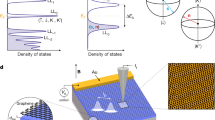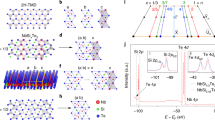Abstract
Transition metal dichalcogenide-based moiré superlattices exhibit strong electron–electron correlations, thus giving rise to strongly correlated quantum phenomena such as generalized Wigner crystal states. Evidence of Wigner crystals in transition metal dichalcogenide moire superlattices has been widely reported from various optical spectroscopy and electrical conductivity measurements, while their microscopic nature has been limited to the basic lattice structure. Theoretical studies predict that unusual quasiparticle excitations across the correlated gap between upper and lower Hubbard bands can arise due to long-range Coulomb interactions in generalized Wigner crystal states. However, the microscopic proof of such quasiparticle excitations is challenging because of the low excitation energy of the Wigner crystal. Here we describe a scanning single-electron charging spectroscopy technique with nanometre spatial resolution and single-electron charge resolution that enables us to directly image electron and hole wavefunctions and to determine the thermodynamic gap of generalized Wigner crystal states in twisted WS2 moiré heterostructures. High-resolution scanning single-electron charging spectroscopy combines scanning tunnelling microscopy with a monolayer graphene sensing layer, thus enabling the generation of individual electron and hole quasiparticles in generalized Wigner crystals. We show that electron and hole quasiparticles have complementary wavefunction distributions and that thermodynamic gaps of ∼50 meV exist for the 1/3 and 2/3 generalized Wigner crystal states in twisted WS2.
This is a preview of subscription content, access via your institution
Access options
Access Nature and 54 other Nature Portfolio journals
Get Nature+, our best-value online-access subscription
$29.99 / 30 days
cancel any time
Subscribe to this journal
Receive 12 print issues and online access
$259.00 per year
only $21.58 per issue
Buy this article
- Purchase on Springer Link
- Instant access to full article PDF
Prices may be subject to local taxes which are calculated during checkout



Similar content being viewed by others
Data availability
The data supporting the findings of this study are included in the main text and in the Supplementary Information files, and are also available at https://github.com/HongyuanLiCMP/Mapping-Charge-Excitations-in-Generalized-Wigner-Crystals.
References
Wigner, E. On the interaction of electrons in metals. Phys. Rev. 46, 1002–1011 (1934).
Regan, E. C. et al. Mott and generalized Wigner crystal states in WSe2/WS2 moiré superlattices. Nature 579, 359–363 (2020).
Xu, Y. et al. Correlated insulating states at fractional fillings of moiré superlattices. Nature 587, 214–218 (2020).
Huang, X. et al. Correlated insulating states at fractional fillings of the WS2/WSe2 moiré lattice. Nat. Phys. 17, 715–719 (2021).
Jin, C. et al. Stripe phases in WSe2/WS2 moiré superlattices. Nat. Mater. 20, 940–944 (2021).
Li, H. et al. Imaging two-dimensional generalized Wigner crystals. Nature 597, 650–654 (2021).
Wang, L. et al. Correlated electronic phases in twisted bilayer transition metal dichalcogenides. Nat. Mater. 19, 861–866 (2020).
Pan, H., Wu, F. & Sarma, S. D. Quantum phase diagram of a moiré–Hubbard model. Phys. Rev. B 102, 201104 (2020).
Tang, Y. et al. Simulation of Hubbard model physics in WSe2/WS2 moiré superlattices. Nature 579, 353–358 (2020).
Li, T. et al. Charge-order-enhanced capacitance in semiconductor moiré superlattices. Nat. Nanotechnol. 16, 1068–1072 (2021).
Slagle, K. & Fu, L. Charge transfer excitations, pair density waves, and superconductivity in moiré materials. Phys. Rev. B 102, 235423 (2020).
Padhi, B., Chitra, R. & Phillips, P. W. Generalized Wigner crystallization in moiré materials. Phys. Rev. B 103, 125146 (2021).
Tessmer, S., Glicofridis, P., Ashoori, R., Levitov, L. & Melloch, M. Subsurface charge accumulation imaging of a quantum Hall liquid. Nature 392, 51–54 (1998).
Finkelstein, G., Glicofridis, P., Ashoori, R. & Shayegan, M. Topographic mapping of the quantum Hall liquid using a few-electron bubble. Science 289, 90–94 (2000).
Steele, G. A., Ashoori, R., Pfeiffer, L. & West, K. Imaging transport resonances in the quantum Hall effect. Phys. Rev. Lett. 95, 136804 (2005).
Zondiner, U. et al. Cascade of phase transitions and Dirac revivals in magic-angle graphene. Nature 582, 203–208 (2020).
Pierce, A. T. et al. Unconventional sequence of correlated Chern insulators in magic-angle twisted bilayer graphene. Nat. Phys. 17, 1210–1215 (2021).
Xie, Y. et al. Fractional Chern insulators in magic-angle twisted bilayer graphene. Nature 600, 439–443 (2021).
Naik, M. H. & Jain, M. Ultraflatbands and shear solitons in moiré patterns of twisted bilayer transition metal dichalcogenides. Phys. Rev. Lett. 121, 266401 (2018).
Teichmann, K. et al. Controlled charge switching on a single donor with a scanning tunneling microscope. Phys. Rev. Lett. 101, 076103 (2008).
Pradhan, N. A., Liu, N., Silien, C. & Ho, W. Atomic scale conductance induced by single impurity charging. Phys. Rev. Lett. 94, 076801 (2005).
Brar, V. W. et al. Gate-controlled ionization and screening of cobalt adatoms on a graphene surface. Nat. Phys. 7, 43–47 (2011).
Wong, D. et al. Characterization and manipulation of individual defects in insulating hexagonal boron nitride using scanning tunnelling microscopy. Nat. Nanotechnol. 10, 949–953 (2015).
Li, H. et al. Imaging local discharge cascades for correlated electrons in WS2/WSe2 moirè superlattices. Nat. Phys. 17, 1114–1119 (2021).
Stomp, R. et al. Detection of single-electron charging in an individual InAs quantum dot by noncontact atomic-force microscopy. Phys. Rev. Lett. 94, 056802 (2005).
Wang, L. et al. One-dimensional electrical contact to a two-dimensional material. Science 342, 614–617 (2013).
Li, H. et al. Electrode-free anodic oxidation nanolithography of low-dimensional materials. Nano Lett. 18, 8011–8015 (2018).
Acknowledgements
This work was primarily funded by the US Department of Energy (DOE), Office of Science, Office of Basic Energy Sciences, Materials Sciences and Engineering Division under contract number DE-AC02-05-CH11231 (van der Waals heterostructure program KCFW16) (device electrode preparation and STM spectroscopy). Support was also provided by the US Army Research Office under MURI award W911NF-17-1-0312 (device layer transfer) and by National Science Foundation (NSF) award DMR-1807233 (surface preparation). S.T acknowledges support from DOE-SC0020653 (materials synthesis), NSF DMR-1955889 (magnetic measurements), NSF CMMI-1933214, NSF 2206987, NSF ECCS 2052527, DMR 2111812 and CMMI 2129412. K.W. and T.T. acknowledge support from the Elemental Strategy Initiative conducted by the Ministry of Education, Culture, Sports, Science and Technology (MEXT), Japan (grant number JPMXP0112101001), the Japan Society for the Promotion of Science (JSPS) KAKENHI (grant number JP20H00354) and the Core Research for Evolutional Science and Technology (CREST) (JPMJCR15F3), Japan Science and Technology Agency (JST) for bulk hBN crystal growth and analysis.
Author information
Authors and Affiliations
Contributions
H.L., M.F.C. and F.W. conceived the project. H.L. and Z.X. performed the STM measurement. H.L., Z.X., E.R. and W.Z. fabricated the heterostructure device. H.L., Z.X., A.Z., M.F.C. and F.W. discussed the experimental design and analyzed the experimental data. R.S., R.B. and S.T. grew the WS2 crystals. K.W. and T.T. grew the hBN single crystal. All authors discussed the results and wrote the paper.
Corresponding authors
Ethics declarations
Competing interests
The authors declare no competing interests.
Peer review
Peer review information
Nature Nanotechnology thanks the anonymous reviewer(s) for their contribution to the peer review of this work.
Additional information
Publisher’s note Springer Nature remains neutral with regard to jurisdictional claims in published maps and institutional affiliations.
Supplementary information
Supplementary Information
Supplementary Figs. 1–12 and Discussion.
Rights and permissions
Springer Nature or its licensor (e.g. a society or other partner) holds exclusive rights to this article under a publishing agreement with the author(s) or other rightsholder(s); author self-archiving of the accepted manuscript version of this article is solely governed by the terms of such publishing agreement and applicable law.
About this article
Cite this article
Li, H., Xiang, Z., Regan, E. et al. Mapping charge excitations in generalized Wigner crystals. Nat. Nanotechnol. (2024). https://doi.org/10.1038/s41565-023-01594-x
Received:
Accepted:
Published:
DOI: https://doi.org/10.1038/s41565-023-01594-x



